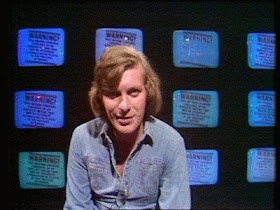You weren’t a fan of touring, but what were your most memorable gigs? You supported some famous names at the time, A Certain Radio, The Fall, Buzzcocks, Joy Division...
SP: Maybe the Nashville in London supporting Joy Division when they were at the height of their powers. Most people would probably disagree with me but I don’t think any of their records captured how intense they could be live. Other than that, supporting Adam and the Ants was always interesting.
A couple of noted names were involved in the sleeve design of some of The Distractions’ records. What was it like working with Peter Saville (Time Goes By So Slow and Nobody’s Perfect) and Kevin Cummins (Nobody’s Perfect and And Then There’s...)?
SP: We knew Peter from the early days at Factory but he pretty much worked on his own. I don’t remember being consulted at all on the Time Goes By So Slow sleeve, although I really liked it. The Nobody’s Perfect sleeve we had a little more say in. It originated from a photo session Kevin had done for Record Mirror where I was standing in front of a billboard with photos of the rest of the band on it. Peter took that and changed it around a little. There’s a really nice detail in that you can see the reflection of the model’s face in the glass of Adrian’s portrait. I believe the model was Peter’s partner at the time though I could be wrong.
The famous Leigh Festival had a formidable line-up, what was it like?
SP: Sparsely attended. I suspect that it was one of Tony Wilson’s great conceptual ideas to put it on in a place exactly equidistant between Manchester and Liverpool. The problem was that Leigh was practically impossible to reach by public transport so the darlings of the music press ended up playing to each other, a few journalists and three members of the Greater Manchester Police Drug Squad, all of whom were dressed like Starsky.
How did the move from TJM to Factory come about, on the back of You’re Not Going Out Dressed Like That or through gigs?
SP: Tony Wilson rang me at work and said Paul Morley was going to make You’re Not Going Out Dressed Like That single of the week in the NME and did we want to do the next single on Factory. We did.
Anthony H Wilson. (c) Avenue and Alleyways.
Did you meet the late Tony Wilson often?
SP: Yes, and my mum used to enjoy talking to him on the phone when he rang up. Tony was a brilliant and frustrating character, the nearest Manchester will ever get to Andy Warhol as a conceptual thinker. The difference was that, unlike Warhol, he talked all the time. And he just did not care. The cowboy boots would have been one thing but wandering about with saddle bags over his shoulder was taking it to another level.
How did Island see you? Was there any pressure to come up with an “image”? To write certain kinds of songs? In other words, as Tony Wilson is said to have put it, "to play the game”?
SP: To be fair to them, they pretty much let us get on with it. The press really liked us so there was no pressure to develop an image or to write in a certain way. The only area where they did step in was in the choice of singles. They wanted to put “Boys Cry” out and I really objected to that as I didn’t want the band to be known for a cover version. Funnily enough, I heard it on the radio a few years ago and thought they were probably right but at the time I sulked.









